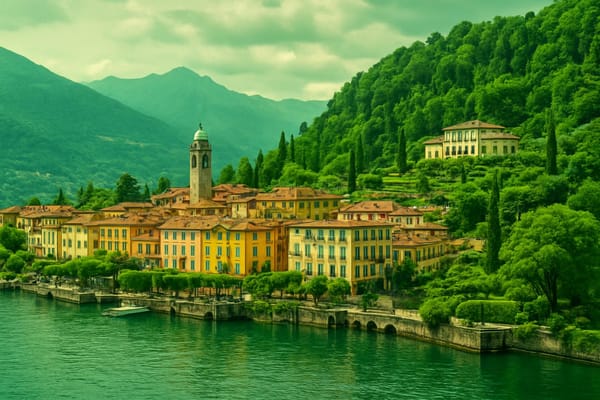Sorrento
Cliffside sea views, lemon groves, limoncello, boat tours, sunsets and charming historic streets.

Important things to know about Sorrento
Sorrento, Italy, is a coastal city where Mediterranean light and lemon-scented breezes shape a gentle rhythm of daily life, blending traditional hospitality with modern comforts. Perched above a rugged coastline, the city’s identity is tied to its maritime character and the surrounding citrus groves that produce the fragrant fruits behind its beloved limoncello; local commerce still includes artisan workshops, family-run restaurants, and small-scale agriculture that sustain a sense of community. Streets hum with a mixture of Neapolitan dialects and international voices, while cafés and bakeries serve as social hubs where neighbors meet to trade news and linger over coffee; this convivial atmosphere is part of what defines Sorrento’s urban culture. Climate plays a role in everyday life, with mild winters and warm summers encouraging outdoor markets, promenades, and a lifestyle centered on fresh, seasonal ingredients-seafood, olives, tomatoes and, of course, citrus-reflected in both home kitchens and eateries. The city balances preservation of tradition-from handicrafts to culinary recipes-with a steady embrace of hospitality services, small-scale commerce and cultural events that bring residents together. Transport links to nearby urban centers shape commuting patterns and economic ties, while local schools, artisan guilds and family businesses contribute to a resilient social fabric. Visitors and residents alike notice immediately the panoramic light, the coastal scent, and the relaxed pace that make Sorrento a distinctive Italian city where everyday life feels both timeless and vibrantly lived.
Sightseeing hot-spots in Sorrento
Sorrento, Italy, is a sun-drenched jewel on the Sorrentine Peninsula where narrow lanes, pastel houses and fragrant lemon trees invite slow discovery. Strolling from Piazza Tasso along the bustling Corso Italia offers a lively mix of cafés, artisan shops and baroque façades, while quiet side streets reveal cozy trattorie and historic churches. The town’s compact size makes it perfect for exploring on foot, and every turn delivers a postcard-worthy vantage point of the Bay of Naples, making Sorrento an ideal base for those seeking both culture and coastal charm.
The waterfront at Marina Grande showcases Sorrento’s maritime soul with colorful fishing boats, fresh seafood restaurants and a relaxed atmosphere that contrasts with the hilltop town center. Boat trips to Capri and the Amalfi Coast depart regularly, promising dramatic cliffs, hidden caves and the chance to swim in sapphire waters. For a taste of local tradition, visit lemon groves and family-run distilleries to sample authentic limoncello, a signature flavor of Sorrento, and pause at the Villa Comunale viewpoint for spectacular sunset panoramas that photograph beautifully and linger in memory.
Beyond the town itself, day trips to Pompeii, Mount Vesuvius and the winding coastal roads of the Amalfi Coast expand the sightseeing options, blending archaeology, hiking and coastal vistas into one richly varied itinerary. Food lovers will relish fresh seafood, handmade pasta and classic Neapolitan desserts in intimate eateries, while photographers and romantics will find countless opportunities for golden-hour shots. Whether you come for scenic overlooks, historic sites or island excursions, Sorrento, Italy, offers unforgettable highlights that cater to every kind of traveler.
Hotels to enjoy in Sorrento
Sorrento is a magnet for travelers seeking comfortable hotels in Sorrento that combine Italian charm with modern convenience. Nestled on the cliffs above the Bay of Naples, Sorrento hotels offer everything from panoramic sea views and rooftop terraces to quaint stays within the historic center where narrow streets lead to lemon gardens and local trattorias. Many properties serve as ideal bases for day trips to Capri, Pompeii, and the Amalfi Coast, with easy access to ferries and regional trains. Whether you're searching for a romantic escape or a longer stay to explore Campania, the town’s hospitality scene blends traditional Bed & Breakfast warmth with larger hotels offering full-service concierge, making it simple to plan excursions, book boat trips, or arrange private transfers to Naples and nearby attractions.
Choosing the right accommodation in Sorrento often comes down to the balance between comfort, location, and budget. Travelers can find elegant luxury hotels with spa services and Michelin-starred dining, intimate boutique properties tucked into cobbled lanes, and more budget-friendly options that still include hearty breakfast and helpful local advice. Families appreciate family-friendly rooms and properties with gardens or a pool, while couples may prefer quieter guesthouses with terrace views at sunset. To make the most of your stay, consider proximity to the marina if you plan frequent boat trips, or the train station for easy journeys to Naples and Pompeii. Booking in advance for high season will secure the best rooms and rates, ensuring a memorable stay in this sun-drenched corner of Italy.
Restaurants to try in Sorrento
Sorrento is a culinary treasure perched above the Bay of Naples, where restaurants range from rustic family-run trattorias to elegant fine dining establishments. In the heart of Sorrento, Italy, narrow streets open onto terraces with sweeping coastal views, and menus celebrate the sea with daily-caught seafood, classic Neapolitan pizza, and rich pasta specialties like gnocchi alla sorrentina. Chefs here emphasize fresh local ingredients, from sun-ripened tomatoes and fragrant basil to the region’s celebrated lemons, which are transformed into fragrant limoncello and zesty sauces. Strolling from Piazza Tasso toward Marina Grande, visitors encounter cozy eateries where the kitchen windows let you watch fishermen bring in the day’s catch, creating a direct connection between sea and plate that defines the best Sorrento restaurants.
Whether you seek a romantic sunset dinner on a cliffside terrace or a lively evening sampling small plates with friends, Sorrento’s dining scene offers memorable experiences that blend tradition and innovation. Many restaurants adopt a farm-to-table approach, pairing locally sourced cheeses and vegetables with expertly prepared fish and shellfish, while wine lists highlight regional vintages from Campania. Seasonal menus and tasting options allow travelers to explore authentic flavors, and intimate courtyards and bustling piazzas provide varied atmospheres for every occasion. For food lovers planning a trip, exploring the diverse restaurants in Sorrento is a delicious way to discover local culture, enjoy spectacular views, and savor the timeless flavors of southern Italy.
Best shopping stops in Sorrento
Sorrento shopping is an unforgettable blend of Mediterranean style and artisan tradition in Sorrento, Italy, where bustling streets lead to treasures both practical and beautiful. Wander along Corso Italia and the charming lanes of Via San Cesareo to find boutiques overflowing with lemon products-from fragrant soaps and candied peel to the must-try limoncello-alongside racks of tailored linen, hand-stitched leather sandals, and delicate gold and coral jewelry. The city’s shops showcase handmade ceramics painted in sunlit blues and yellows, each piece reflecting the Amalfi coast’s vibrant palette. Savoring the local flavors is part of the shopping experience too, with gourmet stores offering olive oil, dried pasta, and unique preserves that make excellent gifts or travel pantry additions. For those seeking distinctive souvenirs, small galleries and independent designers often display limited-run scarves, ceramics, and artisan homeware that capture the spirit of the region.
Beyond the main avenues, the true heart of Sorrento shopping lies in the relationships with local artisans and the inviting atmosphere of family-run shops. Exploring side streets reveals workshops where craftspeople still shape ceramics, stitch leather, and bottle limoncello by hand, offering a glimpse into traditional techniques and the opportunity to purchase truly authentic items. Haggling is gentle and friendly, and vendors are proud to share stories behind their wares, enhancing the value of every purchase. Whether you’re hunting for a special keepsake, a culinary souvenir, or a piece of Amalfi-style decor, Sorrento, Italy delivers a shopping experience that is as photogenic as it is satisfying-perfect for travelers seeking quality, tradition, and a touch of Mediterranean charm.
Nightlife highlights in Sorrento
Sorrento nightlife unfolds with a blend of timeless Italian charm and modern vibrancy, perfect for travelers seeking memorable evenings on the Amalfi Coast. As twilight falls, the lively heart around Piazza Tasso fills with people enjoying the classic aperitivo culture, street performers, and café terraces where conversations flow as easily as the cocktails. Wander toward the bustling marinas and you’ll find cozy wine bars and restaurants serving fresh seafood and local specialties, while rooftop spots provide panoramic views of the sunset over the Bay of Naples. For those who favor music, intimate venues and bars regularly host live music nights ranging from jazz and acoustic sets to upbeat DJ sessions that keep the energy going late into the night.
Beyond the central squares, Sorrento nightlife offers a delightful mix of options for every mood: seaside locales in Marina Grande offer romantic dinners and moonlit strolls, while more energetic clubs and lounges near the town center draw crowds looking to dance until dawn. Don’t miss tasting the region’s famous local limoncello as part of your evening ritual, and consider starting your night with a leisurely seaside aperitif to capture the full sensory appeal of Sorrento after dark. Whether you prefer a relaxed drink with views or a lively night of music and dancing, Sorrento delivers an unforgettable nocturnal experience.
Getting around in Sorrento
Sorrento does not have its own airport, so the most common gateway is Naples International Airport (Napoli Capodichino), roughly an hour to 90 minutes away by road depending on traffic; from there travelers usually take the Alibus to Napoli Centrale/Piazza Garibaldi and transfer to the local Circumvesuviana train for the scenic one-hour ride to Sorrento that stops at Pompeii and other coastal towns, a budget-friendly but often crowded option; alternatives include private direct shuttle services (Curreri) or taxis for a faster, more comfortable transfer, and if you fly into or near Salerno (Costa d’Amalfi) you can reach Sorrento via train or bus with longer travel time but sometimes simpler connections for southern arrivals. Once in Sorrento the transport hub links ferries to Capri and Amalfi Coast towns in high season and SITA buses run the cliffside routes, so planning around train schedules and seasonal ferry timetables will optimize your transfer experience and avoid surprises during peak tourist months.
Culture must-see's in Sorrento
Sorrento’s cultural tapestry is woven from its maritime heritage, sun-drenched lemon groves and a historic center where every narrow lane seems to lead to a new discovery. Strolling from Piazza Tasso through cobbled alleys, visitors encounter the Cattedrale and the elegant halls of the Museo Correale, where local art and archaeological finds reflect centuries of Neapolitan influence. The town is famous for artisanal crafts-particularly intarsio wood inlay and vivid ceramics-and small workshops offer a window into traditional techniques passed down through generations. Culinary culture is central to life here: tasting authentic limoncello, sampling Pasta alla Sorrentina with its fragrant basil and melted mozzarella, or enjoying freshly caught seafood in a marina bistro are quintessential Sorrento experiences that capture the town’s flavors and hospitality.
Beyond food and crafts, Sorrento stages a lively calendar of summer music and theatrical festivals, intimate concerts in historic squares, and religious processions that showcase local customs. The fishing village of Marina Grande preserves a slower rhythm-fishing boats, sea-view cafes and families sharing time-honored recipes-while panoramic terraces and coastal walks afford sweeping views of the Amalfi Coast and the Gulf of Naples. Whether exploring museums and artisan markets, joining a seaside festa, or simply watching the sunset over Vesuvius with a glass of limoncello, the culture highlights of Sorrento offer an immersive, sensory route to understanding this corner of Italy, blending art, food, music and maritime tradition in a way that remains both authentic and deeply memorable.
History of Sorrento
Sorrento's story begins long before modern tourism transformed the coastline, rooted in a layered past that draws archaeologists and travelers alike to the Sorrentine Peninsula. Settled by the Greeks and later absorbed into the Roman world as Surrentum, the town became prized for its mild climate, dramatic cliffs and panoramic views over the Bay of Naples and Mount Vesuvius. Roman villas, mosaics and references in classical literature attest to an early reputation as a retreat for the wealthy, and traces of that era still surface beneath narrow medieval lanes. With the fall of the Western Roman Empire, Sorrento entered a complex medieval tapestry: it passed through Byzantine influence, developed ties with neighboring maritime powers such as Amalfi, and endured raids and power struggles that shaped its urban fabric. The Middle Ages also saw the arrival of Lombard and Norman influences, followed by integration into the Angevin and later Aragonese realms as the Kingdom of Naples consolidated. Cultural figures like the poet Torquato Tasso, born in Sorrento in 1544, contributed to a literary identity that complemented the town’s strategic and commercial roles. Over centuries Sorrento balanced seafaring commerce, agriculture-especially its famed lemon groves-and artisanal trades such as the celebrated wood inlay or intarsio craft, all of which left indelible marks on local architecture and social life.
The modern chapter of the history of Sorrento is dominated by its emergence as a beloved destination on the Grand Tour and by the expansion of travel infrastructure in the 19th and 20th centuries. Victorian and European travelers praised the town’s light, landscapes and classical associations, turning central spaces like Piazza Tasso and harbors such as Marina Grande into icons of Mediterranean leisure. The growth of ferry links, rail and roads linked Sorrento more closely to Naples and to archaeological sites like Pompeii and Herculaneum, boosting heritage tourism while encouraging preservation efforts within the historic center. Local products-most famously the citrus-based liqueur limoncello-and traditions in hospitality and craftsmanship supported a tourism economy that continues to evolve, balancing seasonal influxes with protection of cultural assets. Today, Sorrento harmonizes centuries of Roman, Medieval, and Renaissance influences with contemporary amenities, inviting visitors to explore archaeological remains, religious art, panoramic viewpoints and the enduring charm of narrow streets flanked by cafes, shops and lemon trees-a living history that continues to shape the identity of this jewel on the Amalfi Coast.



